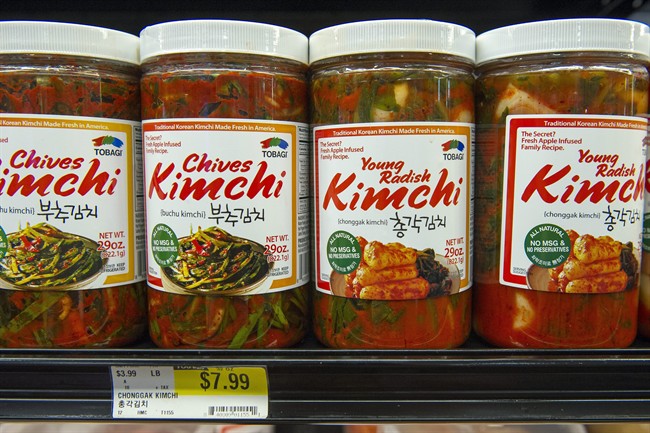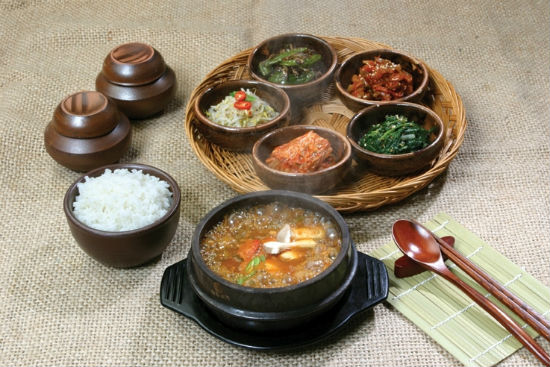- California Assembly OKs highest minimum wage in nation
- S. Korea unveils first graphic cigarette warnings
- US joins with South Korea, Japan in bid to deter North Korea
- LPGA golfer Chun In-gee finally back in action
- S. Korea won’t be top seed in final World Cup qualification round
- US men’s soccer misses 2nd straight Olympics
- US back on track in qualifying with 4-0 win over Guatemala
- High-intensity workout injuries spawn cottage industry
- CDC expands range of Zika mosquitoes into parts of Northeast
- Who knew? ‘The Walking Dead’ is helping families connect
Fueled by heat-seeking Americans, spicy Korean cuisine is now hot
By Michele Kayal, Associated Press
(AP) — When chef Hooni Kim opened his Korean-inspired restaurant Danji in New York City nearly five years ago, he made sure to couch the cuisine’s bold, funky flavors in familiar items: sliders filled with the marinated beef called “bulgogi,” for example, and chicken wings glazed with garlic, honey and sesame seeds.
“I wanted to deliver the flavors in a non-exotic way,” says Kim, who was born in Korea and moved to the U.S. when he was 10. “This was the way to get the non-Korean eaters in to try these flavors. That was my one and only chance to win them over.”
But Kim’s not sure he’d have to use such artifice today. Characterized by tangy fermented vegetables and rich blends of sweet, salt and spice, Korean food was anointed as the new “it” cuisine by industry experts as early as 2012. Since then, a growing fascination with fermentation, the perennial quest for spice, and expert adaptation by trained chefs has nudged Korean food closer to the American mainstream. Major chain restaurants such as Bennigan’s and TGI Friday’s have offered items such as Korean barbecue burgers and Korean tacos, a mash-up of Asian flavors in Mexican format.

Different flavors of Korean Kimchi are displayed in a cooler at the Super H Mart Asian grocery in Fairfax, Va., Monday, July 20, 2015. Classic Korean food items are showing up with more frequency on American menus and grocery shelves. (AP Photo/Cliff Owen)
Despite that, if numbers and attitudes are anything to go on, Korean food isn’t the new Chinese — yet.
“You’ve got your entry point, that’s the barbecue experience and tacos,” says Matt Rodbard, co-author of the upcoming book, “Koreatown: A Cookbook.” ”Those are the gateway drugs of Korean food… But there’s so much more going on.”
Mentions of the word “Korean” on chain restaurant menus have blipped up 2 percent in the last year, according to Chicago-based food industry consulting firm Technomic. Mentions of kimchee, the spicy pickled cabbage dish, have done slightly better, rising 7.5 percent. Still, a National Restaurant Association study of ethnic cuisines to be released in August found that while 61 percent of Americans say they eat Italian food at least once a month, only 4 percent say the same about Korean food. Overall, 50 percent of survey respondents said they’re not at all familiar with Korean food.
Yet Korean food has many attributes that recommend it to the contemporary American diner. The cuisine’s foundation ingredients include doenjang, a fermented soybean paste, and gochujang, a fermented chili paste. These often are used in combination with other ingredients and aromatics to produce a unified experience of salt, sweet, sour, spice.
The magic of this equation arguably first came to wider public notice in 2008 when Roy Choi, a graduate of New York’s Le Bernardin restaurant, began layering double-caramelized Korean short rib into corn tortillas and selling the resulting tacos from a Los Angeles food truck. Since then, chefs such as Kim and others have been liberating the cuisine from the confines of the country’s ethnic Korean neighborhoods and expanding it for a broader audience.
At the Atlanta-area restaurants Sobban and Heirloom Market, husband-and-wife team Cody Taylor and Jiyeon Lee practice an alchemy of Korean flavors and traditional Southern fare. Menu items include kimchee deviled eggs, various tofu preparations, pork, chicken and ribs marinated in gochujang and rubbed with classic barbecue spices, and a spicy pulled pork sandwich topped with Korean pickles.
“You had a lot of classic people who, they see crispy tofu on the menu and they’d be a little turned off,” says Taylor. “But slowly but surely we won a lot of people over with our new classic style of doing it.”
During the last few years, Americans also have discovered fermentation, which was ranked the No. 2 preparation method in the restaurant association’s 2015 “What’s Hot” culinary forecast. The same audience that pays $3 for a bottle of kombucha, a fermented tea, may also be ready for the myriad pickles and fermented flavors of Korean cuisine.
“People are looking for something new,” Kim says. “Even the media is looking for something new to report. It’s an organic process of new, delicious cuisines coming to the limelight.”
And the country that moons over Sriracha also is primed for the smoky, tangy heat of gochujang. The word gochujang gets only a few mentions on chain menus, according to Technomic research. But the spicy paste appears to be leading the migration of Korean ingredients from ethnic groceries to supermarket shelves. And some companies are determined to make it as familiar as ketchup.
As Americans become more familiar with Korean food as a concept, say chefs, retailers and analysts, the range of dishes and ingredients is likely to expand. Cookbook author Rodbard and others point to the exhaustive variety of Korean cuisine, praising its broad repertoire of rice dishes, seafood preparations and famous soups, both hot and cold, often made from unusual ingredients such as Asian pear.
“Asian food in America has exploded,” Rodbard says. “People are talking about Chinese food in terms of regions. They’re going to Japanese kaiseki (multi-course) meals. Korean is the next one of these East Asian and South Asian cuisines to take hold. Americans are very interested in these flavors.”


















kelly
November 25, 2017 at 1:09 PM
yes..I like the basic concepts behind Second Life but it seems incredibly outdated and when I played it was intensely non-intuitive / user friendly to an extent that made EVE look like a game for toddlers. thanks from
togel online